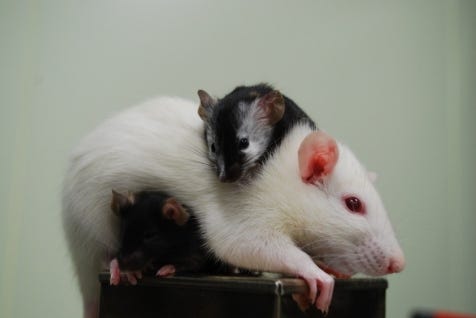Scientists Look to Human-Animal Hybrids for Organ Harvesting
January 12, 2016
The unconventional new approach aims to grow human tissue inside pigs and sheep in an attempt to create hearts, livers, and other organs needed for transplant.
Kristopher Sturgis
|
The Nakauchi lab at Stanford University has developed chimeric mice and rats by injecting cells from one species into the embryo of a different species. So far, the lab has developed mice with genes from rats and vice versa. |
Despite a funding ban put in place by some of America's most respected health agencies, researchers at several different universities continue to move forward with their attempts to explore the growth of human tissue inside human-animal hybrids.
In September of last year the National Institutes of Health (NIH) added their name to the growing list of health agencies renouncing any funding efforts for "human-animal chimera projects" until it can review the scientific and social implications of such endeavors. The agency's statement said it was concerned about the chance of altering the "cognitive state" of animals if they end up with human brain cells.
According to the MIT Technology Review, it's estimated that roughly 20 pregnancies of pig-human or sheep-human chimeras have been established over the last year at a number of different universities. While none of the pregnancies have been brought to term, the technology continues to be refined as researchers look to create chimeras through the use of human stem cells in an animal embryo.
The process relies on several recent breakthroughs in both stem-cell biology and gene editing techniques. The experiments began with the modification of genes to alter the DNA in the embryos of pigs and sheep so that they are genetically incapable of forming a specific tissue. Then researchers add stem cells from a human, in the hopes that the human cells will form the missing organ or tissue, which could eventually be harvested from the animal for use in a transplant operation.
According to the National Kidney Foundation, there are currently 121,678 people waiting for lifesaving organ transplants in the U.S. alone. As the need for organ transplants continues to outgrow the number of donors, so does the need for a more viable solution -- a realization that has fueled many researchers to continue to explore human-animal chimera projects.
As if the issue wasn't already an ethically charged minefield, researchers recently created "humanized" mice endowed with a human immune system -- a discovery that was achieved through the adding of bits of liver and thymus collected from an aborted human fetus. The process, known as "embryo complementation," is controversial not only because of the means by which it is created, but because the human cells can multiply, specialize, and potentially contribute to other parts of the animal's body as it develops.
There is a very real concern that if the human cells can potentially multiply and contribute to other parts of the animal's body -- say, for example, the brain -- then the embryos could develop into something more on the human side. While this is not something scientists expect, it remains a possibility that can't be ruled out until experiments are actually carried out.
While the technology isn't quite at the stage of carrying out such an experiment, the research does appear to be moving along quickly, even without the support of the NIH. And while no scientific papers have been published that can formally describe the technology and its progress, studies involving human-animal chimeras appear to be gaining momentum.
If it can be perfected, scientists estimate that patients on organ waiting lists could someday order a chimera, and receive their needed organ in under a year. With that kind of potential, one can only wonder how long agencies like the NIH can hold back on endorsing a technology that could potentially be a revolutionary alternative for patients who spend months, or sometimes even years on a waiting list for organs, if they ever receive them at all.
Learn more about cutting-edge medical devices at MD&M West, February 9-11 at the Anaheim Convention Center in Anaheim, CA. |
Like what you're reading? Subscribe to our daily e-newsletter.
About the Author(s)
You May Also Like


.png?width=300&auto=webp&quality=80&disable=upscale)
